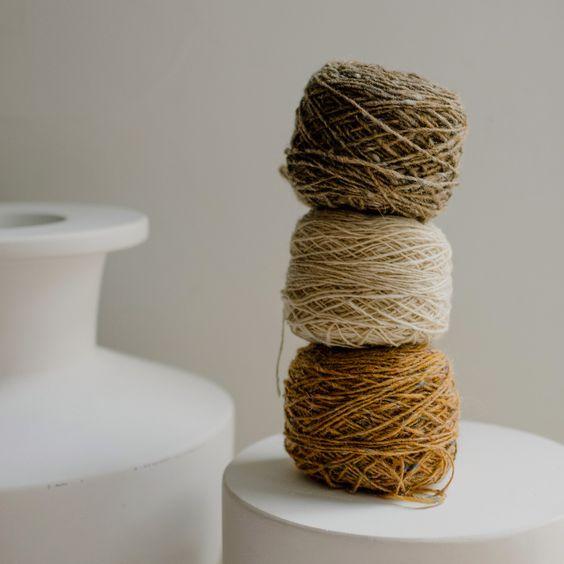Do You Know Yarn Ply And Yarn Thickness Are Not The Same?
Contrary to popular belief, the weight of a thread has little to do with how much it weighs on a meter. What yarn weight refers to is the thickness of the yarn, which can range from almost yarn to super thick. Since most people started knitting with wool yarn, ply simply meant something in terms of yarn weight. Since a ply was often the same amount, a two-ply yarn was quite small, while a six-yarn was far larger.
There isn’t such a term as one-ply yarn. That is referred to as a sole yarn in the technical sense. The individuals are plied to make yarns of varying thicknesses, and there is no doubt any variation of the weight of the yarn depending on the number of plies. A four-ply yarn can be thick or medium weight, while a single yarn can be ultra-thin or super bulky, or something in between. Real! Yarn ply is not the same as yarn thickness! Are you surprised? Are you surprised? You may be, but that’s the fact!
What is ply exactly?
Yarn is made of spun-together fibres that are smooth and solid. The first strands of fibre are spun in single strands, and then two or three strands are spun together to form the final yarn strand.
To ply wool is the technical term for the method of twisting the strands together. A single strand of yarn is called a ‘single,’ but most people refer to it as a ‘single-ply.’ Twisting two singles yields two-ply yarn, three singles yield three-ply yarn, and so on. Plied yarn is usually more durable than single-strand yarn. However, as previously said, strand size can vary greatly. A one-ply yarn, for example, may be thicker than a three-ply yarn. As a result, using ‘ply’ as a standard is not appropriate!
Some people believe that yarn ply has something to do with the weight of yarn you’re dealing with because of conflicting meanings of yarn weights and a touch of knitting history. The reality is much more complex than that. Thus, traditionally, yarn was made from normal thickness plies or strands, and defining a yarn by the amount of these plies included gave a fair indication of the corresponding yarn’s thickness. The finest yarns were 1 or 2-ply (lace weight), DK was 10 ply, and 4-ply was right in the Centre. This was fantastic, and it was easy to see that 2 strands of 4-ply are about the same thickness as DK, and 2 strings of lace thickness are roughly the same as 4-ply. Let’s take a simple example.

What is meant by 4 ply yarn?
I’ve seen variants on this topic posed a lot, so I figured I’d share my thoughts on it. If you are new to yarn crafts or not, the word 4 ply can be perplexing to many knitters and crochets. It may be used to describe the thickness (weight) or shape of the yarn, and it is often contrasted with other, often contradictory expressions when used to describe a specific yarn.
What is the origin of the term?
Ply is described as “a strand of yarn or cord” by the dictionary!
When a fibre is spun, by either hand or by device, the spinner has the option of creating a single thick strand or multiple thinner strands and combining them. This is accomplished by twisting them in the opposite direction of the initial spin, a process known as plying. Because of this arrangement, plied yarns are thicker than a single strand of the same thickness. It’s the same idea that’s used to make solid ropes for ship rigging or suspension bridges, except on a much smaller scale.
However, it is becoming more popular to see yarn constructed from fibres of varying thicknesses, ranging from single strands of bulky weight yarn to very delicate threads made up of several strands. This means that a 4-ply strand of yarn will now range from very fine beehive weight to extremely bulky. 4 Ply is also used to describe the thickness of the yarn in relation to its structure.

Why does it matter?
It is also useful to understand the shape of yarn and its thickness. A plied yarn has different characteristics than a single yarn, and the amount of plies affects the form of the yarn, which may influence how it appears when knitted, but that’s a topic for another blog! It matters since it is perplexing not knowing whether a yarn labelled 4-ply is made up of 4 plies, fingering weight, or both!
Some personal Tips:
- Mixing two brands, even though they tend to be the same ply, is never a good idea because their thickness varies slightly.
- The thickness of dyed yarns is greater than that of white yarns. Meaning, even though the ply is the same, a coloured yarn can feel thicker than a white yarn of the same name.
- Even if they are the same brand, blended yarns are much thicker than dyed and white yarns. Blended indicates that the colour was produced by combining two or more yarn colours.
- So, if you find a yarn that isn’t dense enough for a project, don’t throw it out. Try doubling it and putting it to use. As in, use two strands rather than one.
Hopefully, this article made justice to your queries, and now you are sorted with the chaos of ply and thickness of yarns. ABC Wools is the Only Place to Purchase Wool Yarn Online in India. We’ve been pushing forward since the beginning of our careers. Vardhman Wool & Oswal Wool comes in 600+ different colours, guaranteeing that there is a great yarn colour for the next artistic crochet project. ABC Wools is committed to offering the widest possible range of brand names and high-quality yarns, as well as exceptional customer service at the lowest possible price. We value our customers and will do everything in our power to ensure that you have a fantastic shopping experience with us and that you are satisfied with your purchases.











